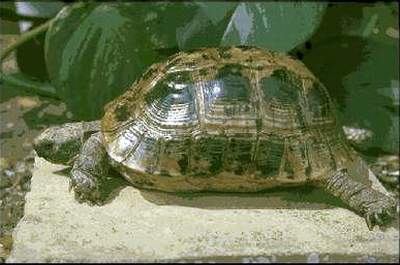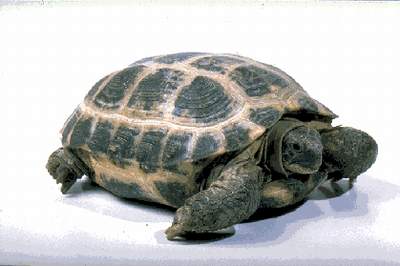With thanks from Richard Gibson, Durrell Wildlife Protection Trust
Testudo graeca graeca
Testudo (graeca) ibera
Testudo graeca terrestris
Testudo graeca zarudnyi
Testudo (graeca) flavominimaralis
Testudo (graeca) whitei
Testudo (graeca) nabuelensis
Testudo hermanni hermanni (robertmertensi)
Testudo hermanni boettgeri
Testudo (Agrionemys) horsfieldi
Testudo marginata
Testudo kleinmanni
Testudo graeca graeca Top
Distribution: North Africa - Morocco, Western Algeria, S.Spain, (N.E.Libya?)
Size: Small Males 130-145mm SCL and - 550g. Females up to 180mm SCL and-1300g
Appearance:
- Highly domed carapace.
- Posterior marginals not flared or serrate.
- Supracaudal undivided and not ventrally intro-flexed.
- Front vertebral scute has clearly rounded anterior margin.
- Ground colour yellow to sandy brown - each scute marked with black with characteristic centre/surround (laterally and anteriorly) Scales of head and limbs are yellow.
- Small spurs present on thighs.
- Lacks tail spur.
- 4-6 rows of enlarged scales on forelimbs.
- Claws - front 5, rear 4.
Testudo (graeca) ibera Top
Distribution: Europe and Middle East - N.E.Greece, Turkey, Bulgaria, S.E.Romania, (southern Yugoslavia?), Iran, Syria, Jordan & Iraq
Size: Significantly larger than T.g.graeca Males up to 180mm SCL and 1200g Females upto 210mm SCL and 2000g
Appearance:
- Broader, flatter carapace.
- Males may have flared and serrate posterior marginals.
- Supracaudal rarely divided.
- Front vertebral scute has angular anterior margin.
- Ground colour greenish to light brown - larger scutes marked with a dark-brown to black central areolar.
older.specimens regularly lose keratin from the surface of the carapace exposing large irregular areas of orange pigment. - Head and nose relatively broad and blunt.
- Eyes relatively large.
- Limbs relatively short and thick.
- 1 or 2 well defined spurs present on thighs.
Testudo graeca terrestris Top
Distribution: Middle East - S.E.Iran, S.W.Afghanistan & western Pakistan
Appearance:
- Smaller and paler than T.(g) ibera.
- Highly domed shell.
- Yellow spot on either side of the head.
Testudo graeca zarudnyi Top
Distribution : As above
Size : Females up to 280mm and 3500g
Appearance
- Narrow, jagged carapace - wider at the rear than the front.
- Posterior marginals flared.
- Supracaudal usually undivided.
- 5th vertebral scute not broader than the 3rd. Nuchal long and narrow.
- Ground colour dark-brown to olive -little visible pattern, marginal edges may have translucent yellow tips.
- Skin light olive-brown.
- Front leg scales black - 5 claws (one smaller). Pointed scales on heels of hind legs.
Testudo (graeca) flavominimaralis (Highfield, not yet recog.) Top
Distribution: Libya
Size: Small Males average 110-120mm SCL
Appearance:
- Elongate carapace.
- Ground colour bright yellow - central dark dot present in vertebral and costal scutes. Marginals edged, sometimes indistinctly with dots "saw-tooth" pattern distinctive in T.g.graeca is ill-defined or absent. Further dark spotting often present over entire carapace.
- Skin orange to yellow - maybe flecked with black. Neck and head bright yellow (Face mask) - bright yellow scale on the top of the head. Front legs yellow with black flecks.
- Plastron duller with dark markings centered around the femoral and abdominal scutes.
Testudo (graeca) whitei! (not yet recog. Placed in the genus by Highfield) Top
Distribution: Coastal and central Algeria
Size: Large Males upto 240mm SCL and 2400g Females upto 280mm SCL and 3500g
Appearance:
- Relatively broad and flat.
- Median carapace width greater than posterior marginal width.
- Posterior marginals often flared and serrate.
- Ground colour typically golden yellow - lacks centre/surround markings, this is sometimes replaced by a medullary "ray" pattern on vertebral and costal scutes.
- Head often yellowish.
- Scales of front legs large and overlapping.
- Large, laterally in-turned spurs present on thighs. Claws - front 5 , rear 4.
- Plastron features large diffuse expanse of black markings.
Testudo (graeca) nabuelensis (not yet recog. Placed in the genus Furculachelys by Highfield) Top
Distrbution: Tunisia
Size: Small Males up to 120mm SCL and females larger.
Appearance:
- Ground colour bright yellow with black markings.
- Vertebrals show centre/surround markings.
- Costals with dark central areoloar and sometimes surrounded with irregular blotches. 2nd,3rd and 4th costals bordered anteriorly and at marginal contact. lst costal lacks anterior border.
- Marginals bordered anteriorly with a narrow black band.
- Plastron marking centered on abdominals.
- Head generally yellow with two bright yellow supranasals.
- Hind feet have spiky yellow scales around heels.Small thigh spurs present, sometimes paired.
Testudo hermanni hermanni (robertmertensi) Top
Distribution: Southern France, Corsica, Balearics and isolated regions of southern Spain
Size: Averages 120-130mm SCL
Appearance:
- Broad, flat, low carapace.
- Black markings on a yellow ground colour.
- Plastron with two solid dark bands running longitudinally from the anal to pectoral scutes, not reaching gular.
- Fixed xiphiplastron.
- Supracaudal often divided.
- Pale yellow/green spot on either side of head. No thigh spurs present.
- Large horny tip to tail, more pronounced in males. Mid-line depth of pectoral scute shortened - 1.5 times smaller than femoral.
- Five claws front and back.
Testudo hermanni boettgeri Top
Distribution: Balkan peninsula - Yugoslavia to Albania, Greece, Bulgaria and Romania
Size: Larger than nominate form, averages 180-220mm SCL
Appearance
- Broad, flat, low carapace.
- Black markings, less well defined than in nominate form, on pale yellow/brown base.
- Plastron markings poorly defined and diffuse. Fixed xiphiplastron.
- Supracaudal often divided.
- No thigh spurs present.
- Large horny tip to tail, more pronounced in males. Four claws front and back (a feature more usually associated with T.horsfieldi).
Testudo (Agrionemys) horsfieldi Top
Distribution: Southern Russia, eastern Iran, Afghanistan and Pakistan
Size: Males up to 140mm SCL and 600g Females up to 190mm SCL and 14OOg
Appearance:
- Flattened, rounded carapace, almost as wide as long. Dull yellow/green to olive colour with dark blotchy markings on carapace and plastron.
- Skin yellowish.
- Four claws front and back.
- Fixed xiphiplastron.
- Supracaudal undivided.
- Long narrow nuchal shield.
- Posterior marginals may be serrate.
- Group of enlarged tubercules present either side of the tail - not large enough to refer to as spurs. Hard horny tip to tail
Testudo marginata Top
Distribution: Mainland and islands of Greece
Size: Males 250-300mm SCL and upto 3000g. Females 240-280mm SCL and upto 3000g
Appearance:
- Elongate carapace - posterior marginals highly flared and serrate.
- Almost entirely dark grey to black, sometimes with pale areolar to larger scutes.
- Plastron tan coloured with distinct triangular markings in pairs.
- Supracaudal undivided.
- Small nuchal shield.
- Notail or thigh spurs.
- Five claws at the front and four at the rear.
Testudo (Pseudotestudo) kleinmanni Top
Distribution: Egypt, Israel and Libya
Size: Males average 100-120mm SCL and up to 170g Females average 120-150mm SCL and up to 400g
Appearance:
- Deep nuchal notch in domed oval carapace. Tan brown to greenish yellow with black markings around the margins of scutes.
- Plastron pale tan with distinct triangular markings usually present. All carapace and plastron markings are less distinct or even absent in animals from Libya.
- Supracaudal undivided.
- No tail or thigh spurs.
Top




